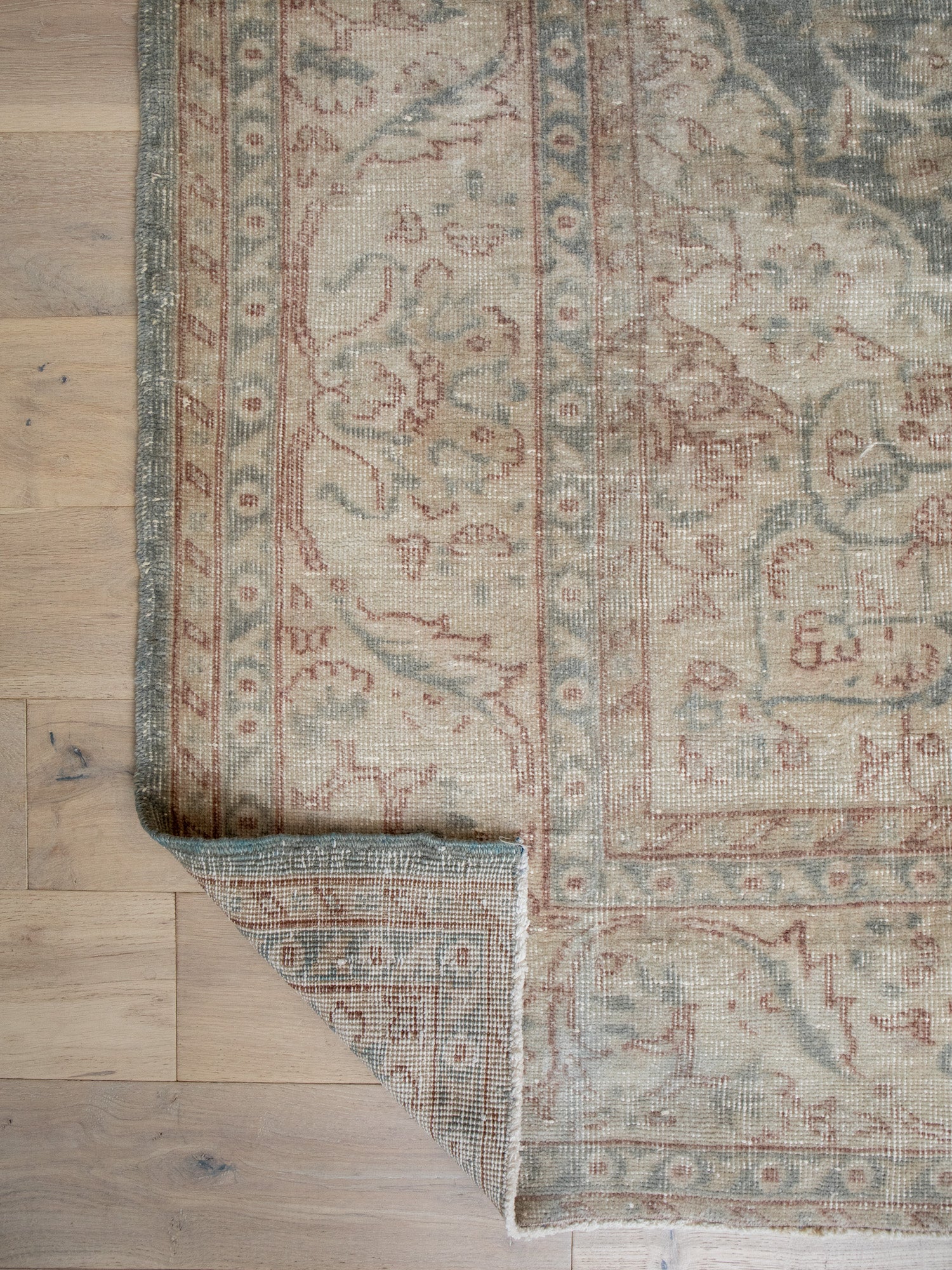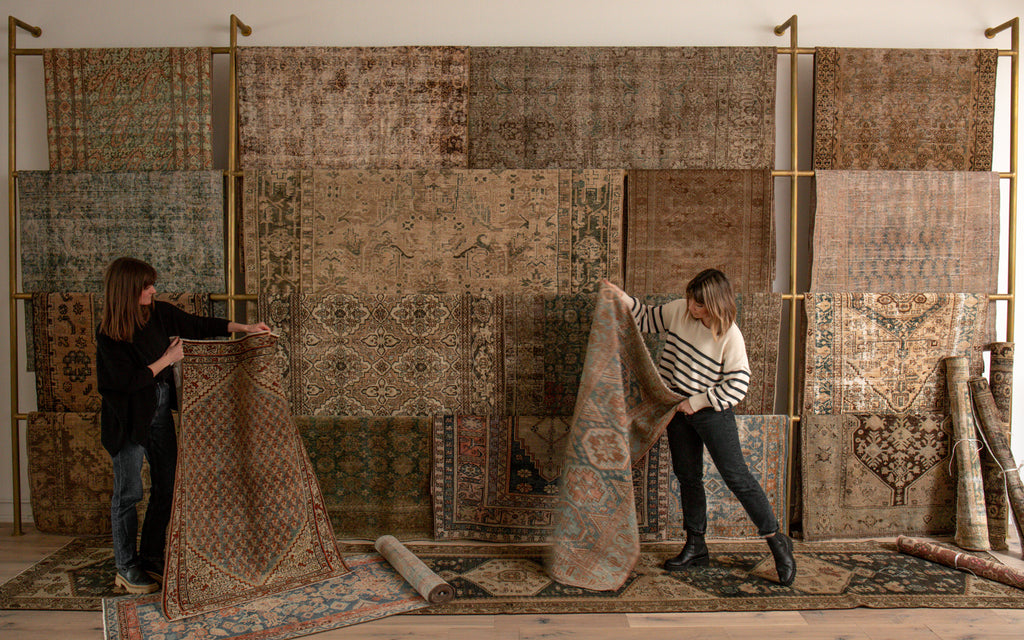At The Vintage Rug Shop, our hand-selected collection of vintage rugs is a celebration of craftsmanship, cultured history, and enduring design over the centuries. Among the many storied rug styles we’ve curated—from rich Mahals to the refined florals of Tabriz—Oushak rugs stand out for their ethereal palettes, primitive designs, and storied Turkish heritage. In this post, we explore the origins, unique characteristics, and unfading appeal of Oushak rugs—the true icons of a well-collected home.

Everything You Need to Know About Oushak Rugs
Oushak rugs stand out for their ethereal palettes, primitive designs, and storied Turkish heritage.

The Origins & Legacy of Oushak Rugs
Named after the town of Usak in western Turkey, Oushak rugs trace their beginnings to the early Ottoman Empire. Revered as one of the great weaving centers of Turkey, Usak was home to master artisans whose works graced the floors of mosques, palaces, and European estates during the 15th and 16th centuries. The golden age of Oushak production aligned with the rise of the European Renaissance—when these Turkish carpets appeared in paintings by Italian and Flemish masters, forever linking them to a legacy of taste and refinement.
Though production waned in later centuries, a resurgence in the early 20th century brought with it a renewed focus on larger scale room-sized rugs crafted for the Western market. This evolution allowed Oushak rugs to take on somewhat of a softer, more transitional look that still speaks fluently to today’s interiors.

Defining Characteristics of Oushak Rugs
What sets Oushak rugs apart is their delicate balance of grand, ornamentally structured motifs and gentle subtlety. The designs—typically more geometric and primitive than those found in other Turkish or Persian rugs—often include stylized florals, angular medallions, and star motifs drawn with a charming, human hand. Rather than the tight symmetry and high knot counts of other Persian rugs, Oushaks embrace imperfection and asymmetry in a way that feels wholly organic.
Equally distinctive is their color palette: soft golds and saffrons, sun-washed apricots, dusty roses, and muted celadons, all dyed using natural vegetable pigments that mellow beautifully over time. This washed-out, tone-on-tone look is what gives Oushaks their unmistakably dreamy character—an ideal complement to interiors that lean towards collected and romantic.
The Craft Behind the Weave
Oushak rugs are hand-knotted with a traditional Turkish knot, known for its strength and longevity. The knotting is typically less dense than that of Persian rugs, contributing to the characteristic softness and pliability of Oushak rugs. While this knot count tends to be lower than some of its counterparts, this is by design—not deficiency. The looser weave gives Oushaks their supple texture and allows their sweeping motifs to breathe. The wool used is often silky, lustrous, and loosely spun, contributing to the plush feel underfoot and a more relaxed drape. The result is a rug that feels artisanal, time-worn and unpretentiously luxurious.

Why Designers Love Oushak Rugs
There’s a reason Oushak rugs are a perennial favorite among interior designers. Their restrained elegance makes them incredibly versatile across a range of aesthetics. In traditional homes, they add a note of age and patina without overpowering the space. In more modern spaces, they act as a grounding layer—softening hard edges and bringing warmth to sleek lines.
We love using smaller Oushak pieces—often referred to as “prayer rugs”—in unexpected places. Tucked in front of a kitchen sink, beside a bathtub, or layered in a hallway, these petite rugs offer a pop of softness and story in high-touch, everyday spaces. Oushaks have a way of anchoring a space while still letting it breathe— a design element that is often hard to achieve otherwise.
EXPLORE VINTAGE OUSHAK RUGS
Collecting & Caring for Your Oushak Rug
Investing in an Oushak rug is like acquiring a piece of living history—one that evolves beautifully with time and wear. The wool fibers grow softer underfoot, and the natural dyes fade into a painterly wash of color that only adds to their charm.
To care for your Oushak, we recommend gentle vacuuming (without a beater bar to avoid pulling out the fibers), professional cleaning every few years, and keeping the rug out of direct sunlight to prevent color fading. Rotate periodically in high-traffic areas, and always blot (never rub!) spills immediately. With mindful care, your Oushak rug will become a lifelong heirloom.
How to Spot a Quality Oushak
If you’re new to collecting vintage rugs, here are a few quick cues to help identify a high-quality, genuine Oushak:
EXPERT TIPS FOR IDENTIFYING AUTHENTIC OUSHAK RUGS
Soft, muted tones of golden hues, peach and celadon, achieved through natural dyes—look for nuanced variations that suggest age and hand-dyeing techniques.
Loose, even knotting on the reverse side—a result of the Turkish (symmetrical) knot, which creates a consistent, plush pile. Unlike Persian knots, which are asymmetrical and allow for a higher knot count and finer details, Turkish knots give Oushaks their soft feel and balanced, geometric look.
Primitive or large-scale motifs that suggest a more primitive, angular and hand-drawn origin, unlike the blooming medallions of some of its counterparts.
High-quality wool that feels smooth, luminous, and slightly oily to the touch—a sign of strong lanolin content and proper wool care.
.jpeg?v=1743030654570)
At The Vintage Rug Shop, we believe in celebrating rugs not just as a piece of home decor, but as stories woven through wool. Oushak rugs are among the most graceful and quietly powerful in our collection—anchored in tradition, softened by time, and beloved by those who appreciate subtle beauty. Their ability to elevate a room while whispering rather than shouting is what makes them a foundational piece in any well-collected home.
Whether you’re just beginning your vintage rug journey or looking to add to your existing collection, an Oushak rug is a beautiful place to start as a heritage-rich investment—one that brings warmth, artisanal charm, and an element of rich history to your everyday living.

